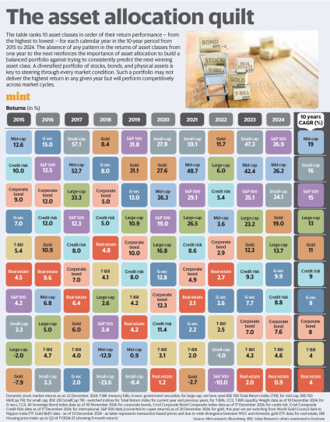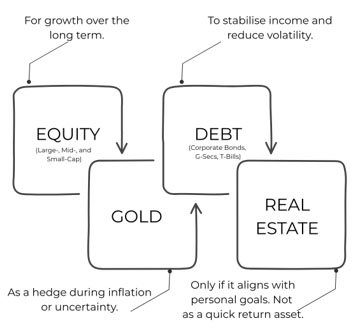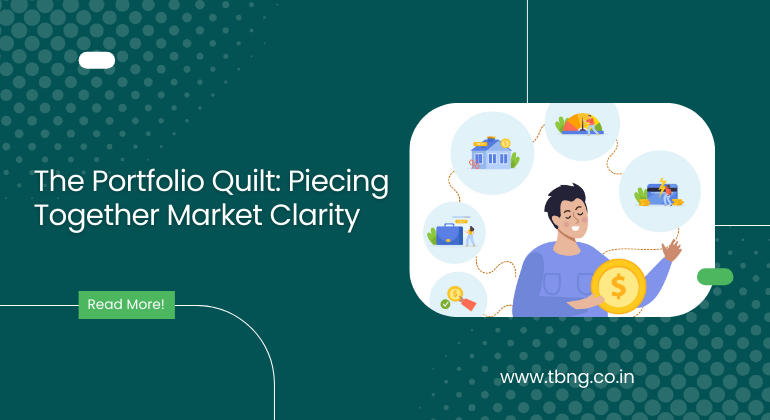If you’ve ever tried to pick the best-performing investment year after year, you’ll know how elusive consistency is. In fact, over the past decade, there hasn’t been a single asset class in India that’s stayed on top for more than two consecutive years. That’s not just interesting, it’s a wake-up call.
Welcome to the world of asset allocation, where long-term success doesn’t come from chasing returns but from spreading your risks wisely.

The ‘Quilt’ of Indian Asset Classes: What the Data Reveals
Between 2015 and 2024, the Indian investment landscape saw dramatic swings across 10 asset classes, including large-cap, mid-cap, and small-cap stocks; gold, real estate, government securities (G-Secs), T-Bills, and credit/debt instruments.
Here are a few eye-opening stats from this 10-year performance quilt:
● Mid-cap equity delivered the highest 10-year CAGR at approx 19%, but also ranked way down low in 2018 and 2019, with returns of -12.9% and 0.9%, respectively.
● Small-cap stocks swung from approximately 59.1% in 2021 to nearly -1.0% in 2022, a brutal reminder that high reward often comes with high volatility.
● Gold had an excellent 27.6% approximate return in 2020, likely driven by pandemic uncertainty, but also returned as low as -2.7% in 2021 and -7.9% in 2015.
● T-Bills, poised as a stable instrument, never ranked high but also never fell into negative territory—a perfect anchor during rough markets.
What does this tell us?
No asset class wins consistently, but a blend of them cushions you across ups and downs.
Why Asset Allocation Beats Prediction
Every year brings new winners and laggards. For example:
● In 2017, mid-caps topped with 52.7% returns. A year later in 2018, they crashed to approximately -12.9%.
● In 2020, gold returned 27.6%, beating even the S&P 500. But the very next year, gold delivered just -2.7%, approximately.
Trying to predict these shifts is not just hard; it’s hazardous to your financial health. Instead, an asset allocation strategy where you divide your investments across equity, debt, and alternatives smoothens the ride and helps you stay invested longer.

What a Diversified Indian Portfolio Might Look Like
Every investor’s goals are different, but for most Indian investors, a balanced portfolio might include these asset classes.
The right mix depends on your age, goals, risk appetite, and cash flow needs, not just on the market trends.
Rebalancing: The Unsung Hero of Returns
The best portfolios are not “set and forget” but reviewed and rebalanced periodically. This ensures you:
This ensures you:
● Take profits off overheated asset classes
● Reinvest into undervalued ones
● Maintain the risk-return balance you started with
For example, had you invested 50% in equities and they grew to 65% due to a market rally, rebalancing would involve shifting some gains into bonds or gold to bring the portfolio back in line.
So, What Should You Do as an Indian Investor?
Here are some prudent, actionable steps:
1. Don’t chase top performers: In 10 years, no single asset class has stayed on top more than once in a row.
2. Diversify across uncorrelated assets: Mix growth (equity), stability (bonds), and protection (gold/T-bills).
3. Match investments to life goals: Equity for long-term, debt for short-term needs.
4. Stay disciplined: Let data, not emotion, guide your moves.
Final Thought: Don’t Pick Winners—Build Resilience
The asset quilt is more than a visual tool. It’s a powerful metaphor: markets are unpredictable, but your financial life doesn’t have to be. By focusing on asset allocation, you stop reacting to noise and start building wealth in a consistent, goal-oriented manner, come volatility, elections, inflation, or global events.

